Why not?
A Tale of rainforests, death-bridges
and mud
Story by RACHEL ROUNDS
Photos by MOLLY JUILLERAT
When most Americans think of Panama, they think of the canal or the 1989 U.S.
invasion, not the country as a vacation destination. When my friend Molly and
I decided to vacation there, we were asked repeatedly by puzzled friends, "Why
Panama?"
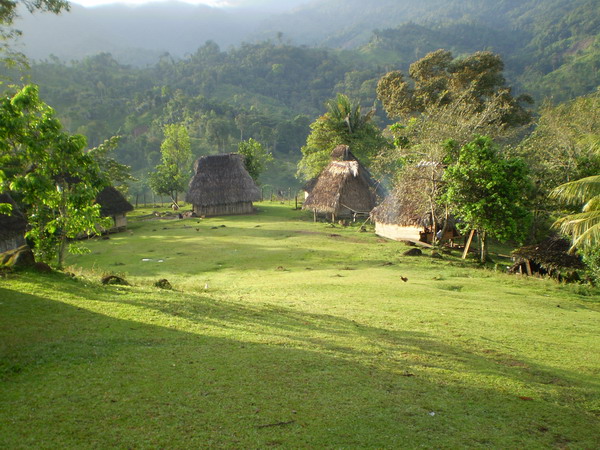 |
|
|
Why Panama? Because of scences like this remote thatched
hut village in Upper Santos Village
|
Molly and I have untraditional ideas about ways and places to travel. We like to pick the craziest, most difficult or improbable sounding idea and set off on itineraries filled with tics, vampire bats, stinging beetles, primitive living conditions and scary river crossings.
As part of our trip, we decided to hike from the mountain town of Boquete to the steamy coast of Bocas del Toro, the town of Norteno along the Rio Robalo, a distance of about 80 kilometers, or about 48 miles. It seemed straightforward enough. We hired a guide, Feliciano, who gave us vague instructions of what to bring and to expect. We needed rubber boots (in the dry season?) mosquito repellant and water treatment pills. And we learned our trek would involve a night in an indigenous Ngobe-Bugle (N-go-bay Boo-glay) village. That piqued our interest even more. How often do you backpack through an indigenous village in a tropical rainforest? And, really, how bad could the mud be?
So we set off for Boquete and met Feliciano, an energetic, slightly frenetic
small man filled with excitement for the hike and Henry, his 17-year-old son.
We headed off with our big packs, trekking poles, hydration packs, cameras,
binoculars and rubber boots, and felt very goofy every time we passed a Ngobe-Bugle
on the trail. They also wore rubber boots, but carried only heavy canvas sacks.
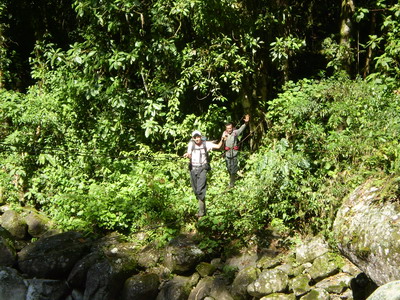 |
 |
|
Feliciano and Henry, ready for excitement
|
Feliciano following the evasive trail
|
When trekking in Patagonia a year earlier I thought there must be more than
one word for “wind.” In Panama, the multiple-meaning word is “mud.”
I would bet my house the Ngobe-Bugle language has more than one word for mud.
We slid and slugged through so many kinds of mud — red, yellow, purple,
pink coral, orange, white, coffee, chocolate and (literally) cow-shit colored
mud. Mud that sucks your boots like quick sand, mud that eats your trekking
pole down to your hand, mud that squeaks, mud that squishes. Molly said hiking
felt like skiing in the mud. You get the picture.
On our first day we hiked across a cleared forest, dodging around cattle -
and had our first experience with mud that would torture us throughout the trek.
The Parque Internacional La Amistad, where we trekked through, allows indigenous
tribes to use the forest as they have traditionally. This includes living, hunting
and grazing cattle in the park. Cattle grazing leads to deforestation and mud.
Once the trees are removed (most likely for firewood and slash and burn for
pasture) their roots no longer absorb copious amounts of rainfall so the clay
soils no longer holds water. The tropical rainforest-turned-cow pasture becomes
a mucky wetland.
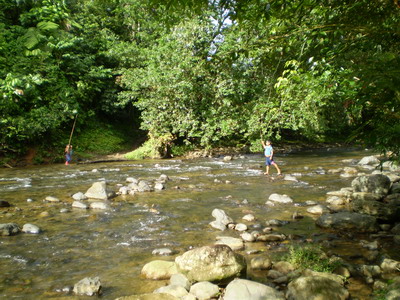 |
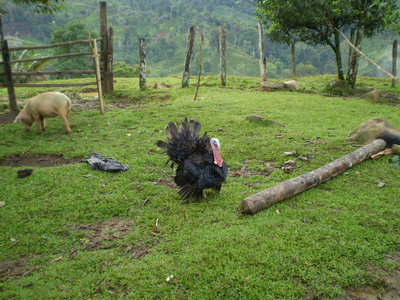 |
|
Ngobe-Bugle kids fishing
|
Future harvest day meal?
|
I silently cursed my way through each mucky cow pasture, both at the torture of walking through the mud and the large cow pies — though sometimes they were hard to distinguish from the mud due to similarities in consistency and color — and the loss of biological diversity and fragmentation of the forest.
Another disappointment was a dead spangle-cheeked tanager, a magnificent bird
full of colors – a pattern and beauty impossible to believe. The bird had
been killed by a Ngobe-Bugle with a slingshot. As an avid birdwatcher and ornithologist,
this was beyond depressing. Our guides condemned the practice, though later
I saw Henry with his own slingshot. Indigenous hunting has also taken a toll
on mammals - we never saw a mammal and heard monkeys only once, quite different
from our experience in other tropical forests. I spent a lot of time while struggling
in the mud debating the merits and balance of indigenous people living in national
parks.
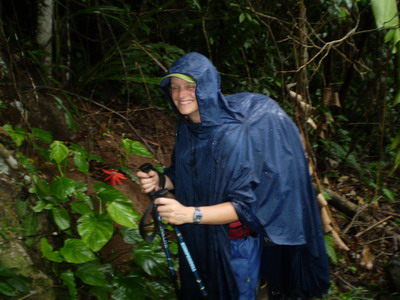 |
 |
|
Molly soaked to the bone
|
Tragic local handy-work with a slingshot
|
That still didn’t distract us from the rainforest’s beauty and diversity.
We marveled at all we saw: tiny inch-long lizards, a bright green frog that
looked like a leaf on the forest floor, brightly and multicolored beetles, and
giant hummingbird-sized flying wasps with stings that can kill a young child.
We saw familiar houseplants growing and blooming in their native soils; leaf
cutting ants carrying slices of leaves greater than their own body sizes; and
bromeliads, orchids, and lianas decorating all the large canopy trees. And birds
– raucous toucans, noisy oropendola and graceful white hawks. The rivers
were charmingly beautiful with large boulders, clear blue-green waters and multiple
waterfalls.
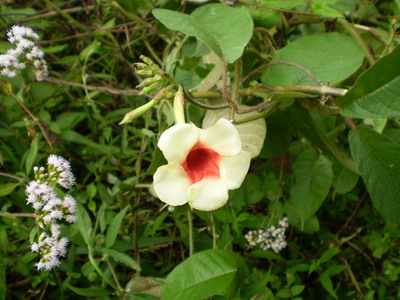 |
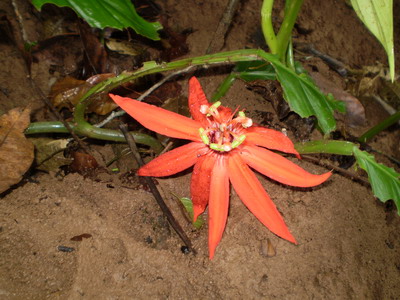 |
|
The Abundant Beauty of Flowers
|
Passionflower
|
But then there were the river crossings - Mom, close your eyes.
When I first saw the “bridge” - a cable no wider than a thick rope for the feet, and one for each hand - I thought surely we didn’t have to cross there. Wrong. The cables weren’t very tight, so they wobbled and swayed. Some of the connections seemed as sturdy as a Lego bridge built by a 5-year-old. But there was no other option.
We crossed three rivers on these cable death-bridges. I inched across, terrified
each time. On the first death-bridge I was so scared my shaking legs made the
cables wobble. Feliciano made fun of me for hours — and didn’t mention
until later that a local had recently died on a crossing.
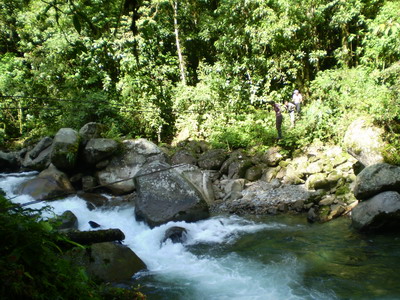 |
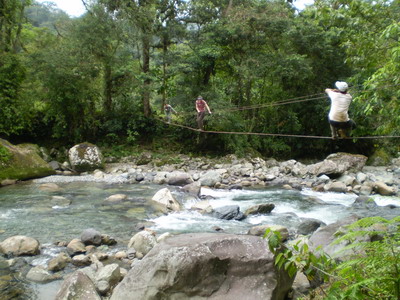 |
|
Baby steps on the cable crossing
|
Rachael in mid-crossing
|
We faced other challenges - sleeping in small and filthy shacks, cockroaches roaming on our faces at night, and no privacy. Living conditions were Spartan and primitive. Our first night there was nowhere to sit, except cow pie-covered planks of wood in the mud beneath the shack we were sleeping in. Santos, the village where we stayed our final night, had no electricity, no roads, no sewage system, no clean water, and only clay mud to cultivate crops on. The “Pobrecitos,” as they call themselves, are the poorest of the poor who live on less than $1 a day.
Santos, located in the Ngobe-Bugle Comarca, an administrative unit with a substantial indigenous population, was unreal, something out of a previous century or a National Geographic special. The youngest children had distended bellies. Chickens and pigs ran everywhere. The thatched huts were dark and gloomy. But the people smiled and were friendly, though they stared at us as much as we stared at them. Some had probably never seen a westerner before, and weren’t we a sight with our big packs, muddy legs, trekking poles and raingear.
Most of the villagers were in the hills because it was summer vacation and
children help their parents in the fields. High school students walk more than
five miles to the nearest school on a muddy trail that crosses the Rio Cano
Sucio 15 times. During the rainy season the river is often too high to cross,
so Santos, a village of about 800 people, is completely isolated. Cattle grazing,
and rice and cassava cultivation occur in the upper elevations, while cocoa
trees and bananas grow below. Each hut houses a large extended family, possibly
20 or more people, and have no beds and little or no furniture.
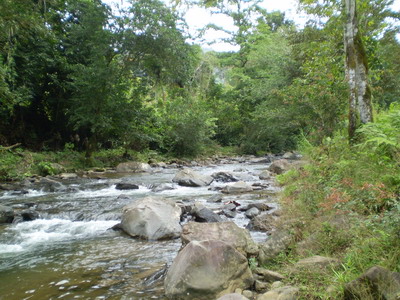 |
 |
|
"We crossed the Rio Cano Sucio 14 times."
|
Feliciano, Rachel, Molly and Henry
|
We saw one small girl walking barefoot carrying a chainsaw as big as her. One boy proudly showed us a hollowed out, but not stuffed, ocelot shot the week before. An elderly woman came to our cooking hut and took a piece of wood out of our fire to take to her fire. Another younger woman casually walked up at dusk and snatched two chickens to take to their night roost. We were amused to learn the youngest boy in one family was named ArchAngelito. A young man who stayed in a room near us one night fell asleep listening to a soccer game on his battery-operated radio. Another insisted on carrying my large pack ahead for me — I declined.
Before we left, Molly gave Star Wars pens to a boy to share with other children and the school. He proudly showed them to the grandmother. We also parted with a poncho that one of the men confusedly tried on. We both regretted not having more useful items to donate. It’s hard to know where to start when the village needs medical care, clean water, and electricity. We felt guilty and uncomfortable with our relative wealth.
We hiked out the last day from Santos to Norteno via the trail that crossed the Rio Cano Sucio River 14 times. We passed other look-alike Ngobe-Bugle villages. By the end, we were exhausted and covered with bites, scratches, blisters, bruises and, of course, mud. It was pure relief to take off the rubber boots and walk on pavement, and know we were heading to Bocas del Toro, the beach, beds and a beer.
Not a typical vacation, perhaps, but unique. We were grateful for the experience, for trekking through the remote Panamanian jungle and meeting the Ngobe-Bugle people.